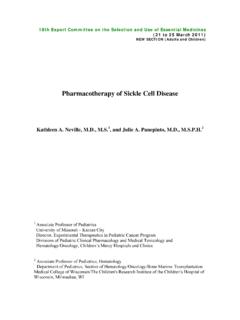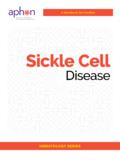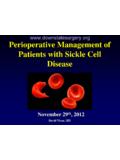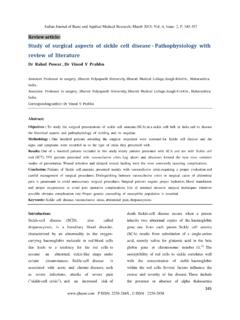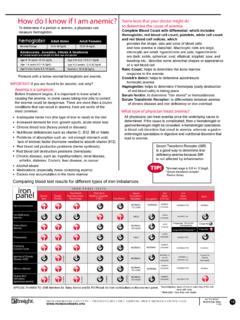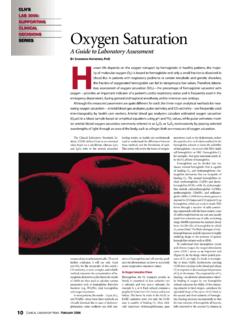Transcription of Sickle Cell Disease in Nigeria -----------A Review
1 IOSR Journal of Dental and Medical Sciences (IOSR-JDMS) e-ISSN: 2279-0853, p-ISSN: 16, Issue 1 Ver. IV (January. 2017), PP 87-94 DOI: 87 | Page Sickle Cell Disease in Nigeria -----------A Review Emechebe GO1,Onyire NB2,Orji ML2, Achigbu KI3 1 Department Of Paediatrics, Chukwuemeka Odumegwu Ojukwu University Teaching Hospital, Awka. 2 Department Of Paediatrics, Federal Teaching Hospital Abakaliki, Ebonyi State 3 Department Of Padiatrics, Federal Medical Center, Owerri Abstract: Sickle cell Disease , a genetically determined Disease is a major cause of mortality and morbidity in Nigeria , a country with the highest burden of the Disease in the world.
2 Information cited in this article was mainly from published works on this subject in Nigeria and elsewhere. The information was extracted over a period of 5months from May 2015 to September2015, from hard copies of scientific Journals, Google search, Pubmed and Hinari websites. Despite recent advances in the management of this disorder in the developed countries, little has changed in Nigeria . It remains a major cause of mortality and morbidity among children in Nigeria . In conclusion, recent breakthroughs in the management of Sickle cell Disease such as genetic screening for pre-implantation and prenatal diagnosis, counseling and fetal selection are not readily accessible in Nigeria Keywords: Sickle Cell Disease , Nigeria .
3 I. Introduction Sickle cell Disease (SCD), a genetically determined haematological disorder is common in Nigeria .[1] It was first observed about 1904 by Dr JB Herrick in the blood of an anaemic West Indian medical student. [1] It is not known exactly when and how or where the mutation producing Sickle cell gene occurred, but it is speculated that it originated in the Middle East amongst the Veddoids in the Arabian Peninsula.[2] Sickle cell gene spread from there into Africa, Southern Europe and India.[2] The Sickle cell trait is found throughout tropical Africa, Southern Europe, Middle East and people of African descent.[2] as shown in Fig I The patient with Sickle cell trait is relatively resistant to the lethal effects of falciparum malaria.
4 [3] The high incidence of this deleterious gene in equatorial Africa is thus explained by the selective advantage for survival it confers in an environment of endemic falciparum malaria. II. Epidermiology Earliest study among adults and children in south-east Nigeria by Lehman and Nwokolo[[4] in 1959 reported Sickle cell trait prevalence of but did not report about homozygous SS. The two commonest haemoglobin variant reported in Nigeria are haemoglobin S (HbS) and haemoglobin C (HbC). HbS is fairly well distributed in Nigeria but HbC seem to be concentrated in western Nigeria and decreases as one move eastward from the west. From 10% in Ghana to in Yoruba land of western Nigeria , to almost non existence in east of the river niger.]
5 [5] By 1982 it was estimated that in Nigeria about 30,000 infants are born each year with SCD.[1,6] It is currently estimated that about 25% of adult Nigerians have Sickle cell trait and 1 to 3% have [1,6-7] Kaine et al[5] found among preschool Igbo in Eastern Nigeria AS, SS and AC. This similar to zero prevalence found among the Igallas east of river Niger in the northern border of Igbo land. III. Genetics/Pathophysiology Sickle Cell Disease is a haemoglobinopathy in which there is substitution of a single amino acid in the beta chain of adult haemoglobin resulting in haemoglobin S, C, D or E depending on amino acid sustitution.
6 [8,9] Haeamoglobin S and C are present in Nigeria while haemoglobin G (HbG), haemoglobin D (HbD) and haemoglobin E (HbE) rarely exist in West Africa.[10] These abnormal haemoglobins are transmitted as autosomal recessive genes.[8,11] Heterozygous inheritance of an abnormal haemoglobin with a normal one results in a symptomless carrier state or trait . Inheritance of haemoglobin S (HbS) with any other abnormal haemoglobin like beta-thalassemia (Bo or B+), HbC, HbS results in SCD. However homozygous inheritance of HbSS is called SCA.[12] In HbS, valine replaces glutamic acid at position 6 in amino acid sequence of beta chain.
7 [11] In haemoglobin C (HbC) lysine replaces glutamic acid at position 6 in the beta chain.[9] While in haemoglobin D (HbD) glutamine replaces glutamic acid at position121 in the amino acid sequence.[9] These amino acid Sickle Cell Disease in Nigeria -----------A Review DOI: 88 | Page substitutions lead to decreased solubility of the haemoglobin molecule in low oxygen tension. Oxygenated HbA and Figure I [2] HbS have the same solubility, but upon deoxygenation the solubility of HbA falls by one half whereas that of the Sickle cell haemoglobin becomes 50 times less soluble.
8 [13] The intra erythrocyte electrolyte concentration is disturbed, with higher sodium, lower potassium and loss of adenosine triphosphate (ATP) leading to red blood cell (RBC) membrane stiffening due to influx of calcium into the cell.[14] High intracellular calcium causes most of the defect characteristic of irreversible sickled cells .[13,14] The most common and most severe haemoglobinpathy is homozygous SS, also called Sickle cell anaemia.[9] Other haemoglobin variants in their homozygous state leads to mild anaemia and a number of phenomena that seem to be specifically related to sickling phenomenon (circulatory catastrophes and infarcts) are not caused by their possession.
9 [14] Combination of HbS with other abnormal haemoglobin leads to clinical state similar but milder than homozygous SS. The spectrum include Sickle cell haemoglobin C Disease HbSC Disease ), Sickle cell Bo-thalasemia, Sickle cell B+-thalassemia and Sickle cell haemoglobin D Punjab (HbSD).[9] Co-polymerization of B6 valine and complimentary region on B chains of adjacent molecule is responsible for the brittle character of Sickle erythrocyte under conditions of decreased oxygenation. [9] Virtually all signs and symptomatology of SCD is attributable to this phenomenon.[9,10]There is a chronic haemolytic anaemia resulting from premature destruction of the brittle poorly deformable erythrocytes.
10 Other manifestations of SCD are attributable to ischaemic changes resulting from vascular occlusion by masses of sickled cell.[9,10] The clinical course of affected children is typically associated with intermittent episodic events often referred to as crisis.[9] The clinical manifestations of SCD result from two key pathological processes: vaso-occlusion and hemolysis.[15,16] Sickle cells , along with non-sickled RBCs, leukocytes, and platelets, form heterocellular aggregates, which adhere to the vascular endothelium, causing obstruction of the lumen of small blood vessels.[17,18] This microcirculatory occlusion leads to acute and chronic tissue ischemia and infarction, with multisystem effects, particularly in bone, lungs, brain, kidneys, and spleen.










